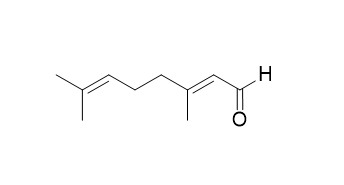Citral
Citral shows appreciable antimicrobial activity against Gram-positive and Gram-negative bacteria as well as fungi. Citral may therefore be of preservative use in addition to its other uses in the food, soap and cosmetic industries. Citral has promising antileishmanial properties, and is a good candidate for further research to develop a new anti-protozoan drug. Citral has antiinflammary activity, it activates PPARα and γ, and regulates COX-2 expression.
Inquire / Order:
manager@chemfaces.com
Technical Inquiries:
service@chemfaces.com
Tel:
+86-27-84237783
Fax:
+86-27-84254680
Address:
1 Building, No. 83, CheCheng Rd., Wuhan Economic and Technological Development Zone, Wuhan, Hubei 430056, PRC
Providing storage is as stated on the product vial and the vial is kept tightly sealed, the product can be stored for up to
24 months(2-8C).
Wherever possible, you should prepare and use solutions on the same day. However, if you need to make up stock solutions in advance, we recommend that you store the solution as aliquots in tightly sealed vials at -20C. Generally, these will be useable for up to two weeks. Before use, and prior to opening the vial we recommend that you allow your product to equilibrate to room temperature for at least 1 hour.
Need more advice on solubility, usage and handling? Please email to: service@chemfaces.com
The packaging of the product may have turned upside down during transportation, resulting in the natural compounds adhering to the neck or cap of the vial. take the vial out of its packaging and gently shake to let the compounds fall to the bottom of the vial. for liquid products, centrifuge at 200-500 RPM to gather the liquid at the bottom of the vial. try to avoid loss or contamination during handling.
Processes2021, 9(11),2065.
Cell Rep.2022, 39(1):110643.
Russian Journal of Bioorganic Chemistry2023, 49:1689�C1698.
Clin Exp Pharmacol Physiol.2015, 42(11):1189-97
Phytomedicine.2019, 67:153159
Molecules.2023, 28(13):4972.
Front Nutr.2023, 10:1181135.
Eur J Pharmacol.2022, 917:174744.
Phys Chem Chem Phys.2018, 20(23):15986-15994
J Agric Food Chem.2020, 68(43):12164-12172.
Related and Featured Products
Letters in Applied Microbiology,2010,9(3):105-108.
Evaluation of the antimicrobial activity of citral.[Reference:
WebLink]
METHODS AND RESULTS:
Citral showed appreciable antimicrobial activity against Gram-positive and Gram-negative bacteria as well as fungi. Media composition and inoculum size had no observable effect on activity but alkaline pH increased Citral activity. The growth rates of Escherichia coli cultures were reduced at concentrations of Citral ≥0·01% v/v while concentrations ≥0·03% v/v produced rapid reduction in viable cells followed by limited regrowth. In a non-growth medium, 0·08% and 0·1% v/v showed rapid bactericidal effects.
CONCLUSIONS:
Citral may therefore be of preservative use in addition to its other uses in the food, soap and cosmetic industries.
Parasitology Research, 2009, 105(6):1489-96.
In vitro activity of the essential oil of Cymbopogon citratus and its major component (citral) on Leishmania amazonensis.[Reference:
WebLink]
Leishmaniasis causes considerable mortality throughout the world, affecting more than 12 million people. Cymbopogon citratus (DC) Stapf, Family Poaceae, is a widely used herb in tropical countries and is also known as a source of ethnomedicines.
METHODS AND RESULTS:
In this study, the inhibitory effect and the morphological and ultrastructural alterations on Leishmania amazonensis by the essential oil (EO) of C. citratus and its main constituent, Citral, were evaluated. The results showed that the antiproliferative activity of EO on promastigotes and axenic amastigotes, and intracellular amastigote forms of L. amazonensis was significantly better than Citral, and indicated a dose-dependent effect. Neither compound showed a cytotoxic effect on macrophage strain J774G8. The promastigote forms of L. amazonensis underwent remarkable morphological and ultrastructural alterations compared with untreated cultures. These alterations were visible by light, scanning, and transmission electron microscopy of promastigotes treated with EO and Citral at concentrations corresponding to the IC50 (1.7 and 8.0 µg/ml) and IC90 (3.2 and 25 µg/ml), respectively, after 72 h of incubation.
CONCLUSIONS:
This study revealed that Citral-rich essential oil from C. citratus has promising antileishmanial properties, and is a good candidate for further research to develop a new anti-protozoan drug.
Fitoterapia, 2009, 80(5):290-296.
Effect of citral, eugenol, nerolidol and α-terpineol on the ultrastructural changes of Trichophyton mentagrophytes.[Reference:
WebLink]
The antifungal effects of Citral, eugenol, nerolidol and α-terpineol on Trichophyton mentagrophytes were investigated.
METHODS AND RESULTS:
Citral over 0.1 mg/ml strongly inhibited the hyphal growth of T. mentagrophytes, and the antifungal activity of α-terpineol was less effective. The morphological changes of the fungus exposed to the terpenes were observed by electron microscopy. The hyphae were distorted and collapsed at 0.2, 0.4 and 1 mg/ml of eugenol, nerolidol and α-terpineol respectively, and cell membrane and organelles were irreversibly damaged at 0.2 mg/ml Citral.
CONCLUSIONS:
These suggested that four terpenes possess antifungal activity against T. mentagrophytes, and the activity might lead to irreversible cellular disruption.
Biochim Biophys Acta, 2010, 1801(11):1214-1220.
Citral, a component of lemongrass oil, activates PPARα and γ and suppresses COX-2 expression.[Reference:
WebLink]
Lemongrass is a widely used herb as a food flavoring, as a perfume, and for its analgesic and anti-inflammatory purposes; however, the molecular mechanisms of these effects have not been elucidated. Previously, we identified carvacrol from the essential oil of thyme as a suppressor of cyclooxygenase (COX)-2, a key enzyme for prostaglandin synthesis, and also an activator of peroxisome proliferator-activated receptor (PPAR), a molecular target for “lifestyle-related” diseases.
METHODS AND RESULTS:
In this study, we evaluated the essential oil of lemongrass using our established assays for COX-2 and PPARs. We found that COX-2 promoter activity was suppressed by lemongrass oil in cell-based transfection assays, and we identified Citral as a major component in the suppression of COX-2 expression and as an activator of PPARα and γ. PPARγ-dependent suppression of COX-2 promoter activity was observed in response to Citral treatment. In human macrophage-like U937 cells, Citral suppressed both LPS-induced COX-2 mRNA and protein expression, dose-dependently. Moreover, Citral induced the mRNA expression of the PPARα-responsive carnitine palmitoyltransferase 1 gene and the PPARγ-responsive fatty acid binding protein 4 gene, suggesting that Citral activates PPARα and γ, and regulates COX-2 expression.
CONCLUSIONS:
These results are important for understanding the anti-inflammatory and anti-lifestyle-related disease properties of lemongrass.



